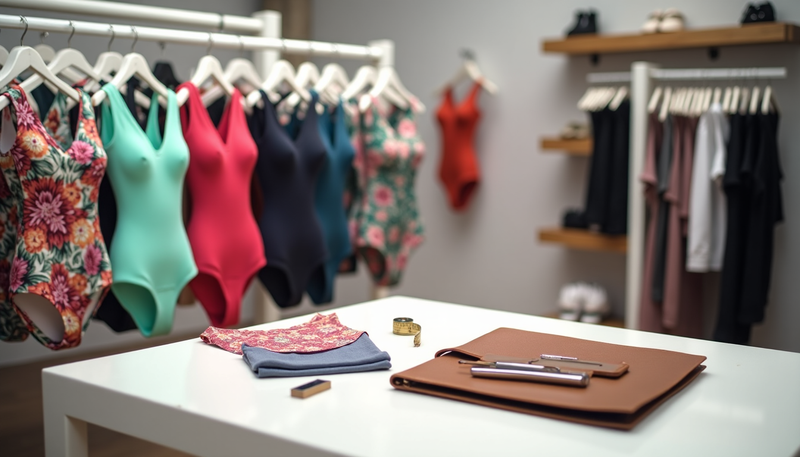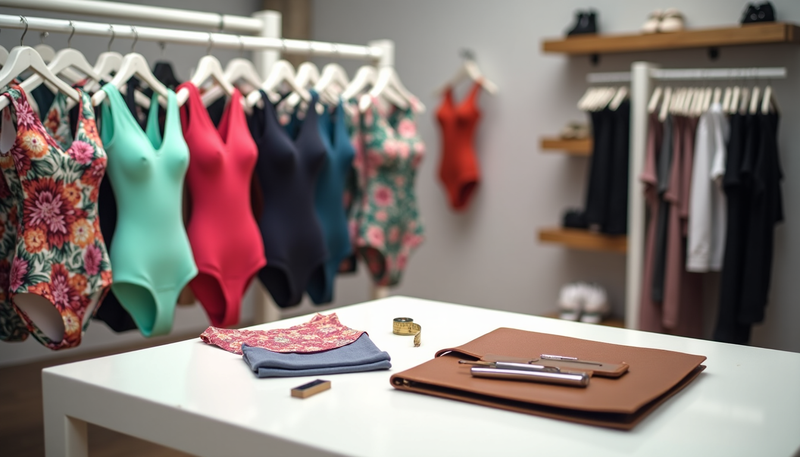
The swimwear market is making waves and will reach $29.1 billion by 2025. The timing couldn't be better to start a swimwear line or explore the wholesale market, as the industry grows 6.2% each year.
Starting a swimwear business takes more than creating beautiful designs. You just need to plan carefully and understand the industry. This includes finding reliable manufacturers in major hubs like the USA, Italy, and Brazil, plus managing seasonal demands and minimum order quantities.
The opportunities for new wholesale swimwear brands look promising, with over 7,500 buyers attending major events like SwimShow in Miami. New brands can stand out by using environmentally responsible materials that customers want more than ever.
Let's take a closer look at what you should know to launch a successful wholesale swimwear business. We'll show you the key steps, from understanding market trends to creating profitable relationships with retailers.
Understanding the Wholesale Swimwear Market
"The global swimwear market was valued at USD 21.22 billion in 2024. The market is projected to be worth USD 22.04 billion in 2025 and reach USD 30.59 billion by 2032, exhibiting a CAGR of 4.79% during the forecast period." — Fortune Business Insights, Market research and consulting organization
The swimwear wholesale market offers excellent opportunities, with global valuations reaching $23.1 billion in 2023 [1]. Market projections show growth to $38.37 billion by 2032 [2].
Current Market Size and Trends
The Asia Pacific region controls 36.1% of revenue share [1], and North America remains a profitable market. Higher disposable income and people's interest in water activities drive market expansion. Speedo has picked up on this by launching swimwear made from 82% recycled materials [3], showing how sustainability shapes the industry.
Key market trends include:
People want eco-friendly materials and sustainable production
Brands focus on inclusive sizing and diverse body types
Advanced fabric technologies shape products
Online sales channels continue to grow
Key Player Analysis
Adidas AG, Nike Inc., Arena Italia S.p.A., and Swimwear Anywhere Inc [1] dominate the wholesale swimwear market. These companies stay ahead through innovation and mutually beneficial alliances with athletes and sports associations [4].
Profit Potential in Wholesale
A swimwear line can be quite profitable, with margins typically between 50% to 60% [5]. To cite an instance, a swimsuit costing $20 to produce can wholesale from $30 to $36 [5]. Bulk buying helps negotiate better with suppliers and reduces the cost per unit.
Smart pricing and volume sales boost profits. The numbers tell the story - selling 500 swimsuits at $75 each brings in $37,500 in revenue and roughly $22,500 in profit after expenses [6].
Setting Up Your Wholesale Operation
"To cite an instance, a swimsuit with a USD 50.00 manufacturing cost reaches retailers at USD 100.00 and ended up costing consumers USD 200.00" — Swimsuit Custom, Swimwear industry analyst
Starting a wholesale swimwear business needs you to focus on legal rules and smart pricing choices.
Legal Requirements for Wholesaling
Federal laws set specific rules for textile and wool products [7]. We focused on proper labeling that shows fiber content, country of origin, and manufacturer details. The Consumer Product Safety Improvement Act (CPSIA) watches over swimwear safety standards [8].
Everything in legal compliance has:
Business license and sales tax permit
Employer Identification Number (EIN)
Product safety certifications
Care labeling compliance
International Organization for Standardization (ISO) certification
Pricing and Margin Strategies
A profitable wholesale business starts by calculating the Cost of Goods Manufactured (COGM). Your wholesale operation should target a 30% to 50% profit margin [9]. The math is simple - if your production costs are $5 per unit, a $10 wholesale price will give a 50% margin [9].
Payment terms need careful thought in wholesale agreements. Retailers usually look for flexible payment options that include net-15, net-30, or net-90 day terms [10]. Clear payment schedules and extra fees for customization help keep your cash flow steady [11].
Minimum order quantities (MOQs) make your pricing strategy stronger. Volume-based discounts are a great way to get bigger orders while staying profitable [10]. The manufacturer's suggested retail price (MSRP) stops retailers from undercutting each other and protects your brand's value in the market [9].
Sourcing Quality Swimwear Products
Quality manufacturers are the life-blood of launching a successful swimwear line. We verified that manufacturers should maintain international certifications like ISO and BSCI. These certifications validate their dedication to quality management and social responsibility [12].
Finding Reliable Manufacturers
Evaluating production capabilities and expertise marks the first step in finding trustworthy manufacturers. Manufacturers should showcase state-of-the-art technology and skilled workforce effectively [13]. Beyond technical prowess, manufacturers must provide:
Eco-friendly material options like ECONYL® and REPREVE®
Professional photo and video services
Optimized ordering processes
Design customization options
Individual-specific guidance [14]
Quality Control Standards
Swimwear manufacturing demands strict testing throughout production phases [15]. Manufacturers should perform comprehensive checks of fabric quality, cutting accuracy, and seam durability instead of final inspections alone [16]. Tests must confirm colorfastness against chlorine, saltwater, and UV exposure [16].
Minimum Order Requirements
MOQ requirements vary substantially between manufacturers, with ranges from 100 to 100,000 units [17]. Notwithstanding that, some manufacturers show flexibility by allowing style combinations to meet total MOQ needs. To cite an instance, see how a 100-piece MOQ could include 40 tops, 40 bottoms, and 20 one-pieces [17]. Each style, color, or print typically needs 20 pieces minimum, while size requirements can be as low as 3 pieces [18].
Building Retailer Relationships
Strong retailer relationships are essential to your wholesale operation's success. As you focus on building partnerships, it’s also crucial to have a clear understanding of how to set up and market your swimwear line. If you’re looking to create your own swimwear brand along with a wholesale operation, our How to Start a Swimwear Brand: A Step-by-Step Guide will walk you through the essential steps.
Identifying Target Retailers
Your target market emerges from analyzing customer demographics, lifestyle priorities, and buying behaviors [19]. Brand loyalty drives buying decisions, so getting a full picture through online platforms and in-person surveys helps you find ideal retail partners [19]. Detailed customer profiles help focus your marketing efforts and guide retailer selection.
Creating Wholesale Catalogs
Professional catalogs are powerful sales tools that showcase your swimwear line completely. A well-laid-out catalog has:
High-definition product images
Detailed specifications and pricing
Brand story and mission statement
Ordering information and policies [20]
Your catalogs should reflect consistent branding in layout, colors, and content presentation [20]. Digital catalogs are convenient, but printed versions create a hands-on experience that boosts product appeal [20].
Payment Terms and Policies
Clear payment structures protect your business interests. Net-30 terms are standard in the industry [21], but new wholesale operations should think over upfront payments through credit cards or COD (Cash on Delivery) [21]. Return policies give retailers 7-14 days to assess products [22], and suppliers often charge restocking fees of 20-25% [23].
Regular communication builds trust and strengthens retailer relationships [24]. Customized support and transparent policies encourage long-term partnerships [25]. Setting clear expectations and delivering quality products helps your swimwear line build lasting retailer relationships that accelerate growth.
Conclusion
The wholesale swimwear business presents exciting opportunities in today's growing market. Your success relies on a few essential elements: quality manufacturers, smart pricing strategies and strong connections with retailers.
Quality standards and legal compliance will give your business long-term stability. The venture becomes particularly attractive with profit margins of 50-60%, especially when you combine strategic pricing with volume-based sales.
Note that solid relationships with retailers are the foundation of wholesale operations. Your swimwear line can thrive in this competitive market if you focus on clear communication, professional catalogs and reasonable payment terms. With the right market insights and business strategy, you can build a profitable wholesale swimwear business that meets the growing consumer demand.
FAQs
Q1. How do I start a wholesale swimwear business? To start a wholesale swimwear business, begin by researching the market and identifying your target audience. Develop a unique product line, create a business plan, and source quality manufacturers. Set up your legal requirements, establish pricing strategies, and build relationships with retailers. Finally, create professional catalogs and implement effective marketing strategies to promote your brand.
Q2. What are the profit margins in wholesale swimwear? Wholesale swimwear typically offers profit margins ranging from 50% to 60%. For example, a swimsuit with a production cost of $20 can be wholesaled for $30 to $36. By implementing strategic pricing and focusing on volume sales, you can potentially increase your profitability in this market.
Q3. How important is sustainability in the swimwear industry? Sustainability has become a significant trend in the swimwear industry. Consumers are increasingly demanding eco-friendly materials and sustainable production practices. Many successful brands are now launching collections made from recycled materials, and focusing on sustainable practices can give your business a competitive edge in the market.
Q4. What are the legal requirements for starting a wholesale swimwear business? Legal requirements for a wholesale swimwear business include obtaining a business license, sales tax permit, and Employer Identification Number (EIN). You must also comply with federal regulations for textile products, including proper labeling of fiber content, country of origin, and manufacturer identification. Additionally, ensure your products meet safety standards set by the Consumer Product Safety Improvement Act (CPSIA).
Q5. How can I build strong relationships with retailers? To build strong relationships with retailers, start by identifying your target market and creating detailed customer profiles. Develop professional catalogs that showcase your products effectively. Establish clear payment terms and policies, and consider offering flexible options like net-30 terms. Maintain consistent communication, provide personalized support, and deliver high-quality products consistently to foster trust and long-term partnerships.
References
[1] - https://www.grandviewresearch.com/industry-analysis/swimwear-market
[2] - https://www.skyquestt.com/report/swimwear-market
[3] - https://www.fortunebusinessinsights.com/swimwear-market-103877
[4] - https://www.mordorintelligence.com/industry-reports/swimwear-market-industry
[5] - https://www.uphance.com/blog/wholesale-prices/
[6] - https://modaknits.com/is-selling-swimsuits-profitable/
[7] - https://www.ftc.gov/news-events/topics/tools-consumers/apparel-labeling
[8] - https://siccode.com/extended-naics-code/424350-68/swimwear-accessories-wholesale
[9] - https://www.shopify.com/retail/product-pricing-for-wholesale-and-retail
[10] - https://www.shopify.com/blog/selling-wholesale
[11] - https://www.abelyfashion.com/what-s-the-process-of-working-with-a-wholesale-swimwear-manufacturer.html
[12] - https://www.abelyfashion.com/what-should-you-look-for-in-a-reliable-wholesale-swimwear-supplier.html
[13] - https://www.abelyfashion.com/what-s-the-minimum-order-quantity-for-custom-swimwear-production.html
[14] - https://baliswim.com/wholesale-swimwear/
[15] - https://baliswim.com/finding-the-right-swimwear-manufacturer-for-your-brand/
[16] - https://balisummer.com/quality-control-and-cost-efficiency-swimwear-manufacturing-hacks/
[17] - https://baliswim.com/need-to-know-about-moq/
[18] - https://baliswim.com/production/
[19] - https://baliswim.com/whos-your-ideal-swimwear-customer-target-market/
[20] - https://www.newprint.com/catalogs?srsltid=AfmBOoqeKTHwoTYosVJT5AypUY5u_PO5Hk5LD3YwzeisszmVJmZVGhMT
[21] - https://fashion-incubator.com/establishing_payment_terms/
[22] - https://brandsgateway.com/blog/best-wholesale-swimwear-suppliers/
[23] - https://www.boldandgritty.com/wholesale?srsltid=AfmBOoqRgwpZWy356VFnYfbsF03VLsX2OkbaRf4yLbnI9BafM-5CT8wi
[24] - https://www.forbes.com/sites/njfalk/2020/04/28/the-5-marketing-musts-frankies-bikinis-is-using-in-uncertain-times-to-propel-wait-lists-and-sell-out-its-sexy-swimwear-line/
[25] - https://www.linkedin.com/pulse/how-sell-bikinis-anything-else-retail-bruce-hurwitz
